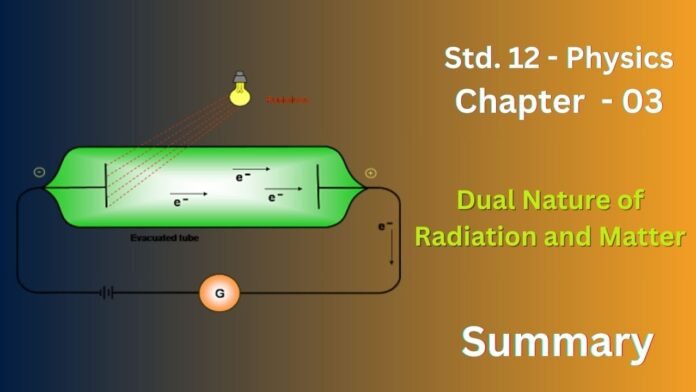The chapter “Dual Nature of Radiation and Matter” from the 12th standard physics part 2 NCERT textbook explores the wave-particle duality of both light (radiation) and matter. It begins by discussing the limitations of classical physics in explaining phenomena like the photoelectric effect.
Key Concepts:
- Photoelectric Effect: This phenomenon, where electrons are emitted from a metal surface when light shines on it, provided evidence for the particle-like nature of light. Crucially, the energy of the emitted electrons depends on the frequency of the light, not its intensity. This led to the concept of light quanta, or photons, where each photon carries a specific amount of energy proportional to its frequency (E = hf).
- Einstein’s Photoelectric Equation: This equation mathematically describes the photoelectric effect: hf = Φ + KE_max, where hf is the photon’s energy, Φ is the work function (minimum energy to liberate an electron), and KE_max is the maximum kinetic energy of the emitted electrons.
- Wave Nature of Matter (de Broglie Hypothesis): If light can behave like particles, de Broglie proposed that matter (like electrons) can also exhibit wave-like properties. He postulated that every moving particle has an associated wavelength (de Broglie wavelength) given by λ = h/p, where p is the momentum of the particle.
- Davisson-Germer Experiment: This experiment provided experimental confirmation of de Broglie’s hypothesis by demonstrating the diffraction of electrons, a phenomenon characteristic of waves.
- Heisenberg Uncertainty Principle: This principle states that it’s impossible to simultaneously know both the exact position and the exact momentum of a particle.
Exercise
1. Find the
(a) maximum frequency, and
(b) minimum wavelength of X-rays produced by 30 kV electrons.
Ans :
Given Information
- Accelerating voltage (V)
- = 30 kV = 30 x 10^3 V
- Charge of an electron (e)
- = 1.6 x 10^-19 C
- Planck’s constant (h)
- = 6.626 x 10^-34 Js
- Speed of light (c)
- = 3 x 10^8 m/s
(a) Maximum Frequency
- Energy of the electron: E = eV = (1.6 x 10^-19 C) * (30 x 10^3 V) = 4.8 x 10^-15 J
- Maximum frequency of X-rays: All the electron’s energy is converted to X-ray photon energy: E = hf_max f_max = E / h = (4.8 x 10^-15 J) / (6.626 x 10^-34 Js) ≈ 7.24 x 10^18 Hz
(b) Minimum Wavelength
- Relationship between frequency and wavelength: c = fλ or
λ = c/f
- Minimum wavelength corresponds to maximum frequency: λ_min = c / f_max = (3 x 10^8 m/s) / (7.24 x 10^18 Hz) ≈ 4.14 x 10^-11 m or 0.0414 nm
2. The work function of caesium metal is 2.14 eV. When light of frequency 6×10^14Hz is incident on the metal surface, photoemission of electrons occurs. What is the
(a) maximum kinetic energy of the emitted electrons,
(b) Stopping potential, and
(c) maximum speed of the emitted photoelectrons?
Ans :
Given Information
- Work function of caesium (Φ) = 2.14 eV
- Frequency of incident light (f) = 6 x 10^14 Hz
- Planck’s constant (h)
- = 6.626 x 10^-34 Js
- Elementary charge (e) = 1.6 x 10^-19 C
- Mass of electron (m)
- = 9.11 x 10^-31 kg
Calculations
(a) Maximum Kinetic Energy (KE_max)
- Convert work function to Joules: Φ = 2.14 eV * (1.6 x 10^-19 J/eV) = 3.424 x 10^-19 J
- Calculate the energy of the incident photon: E = hf = (6.626 x 10^-34 Js) * (6 x 10^14 Hz) = 3.9756 x 10^-19 J
- Use Einstein’s equation: KE_max = E – Φ = 3.9756 x 10^-19 J – 3.424 x 10^-19 J = 0.5516 x 10^-19 J
- Convert KE_max back to eV (optional): KE_max = (0.5516 x 10^-19 J) / (1.6 x 10^-19 J/eV) ≈ 0.345 eV
(b) Stopping Potential (V₀)
KE_max = eV₀
V₀ = KE_max / e = (0.5516 x 10^-19 J) / (1.6 x 10^-19 C) ≈ 0.345 V (Notice that the stopping potential in volts is numerically equal to the maximum kinetic energy in eV).
(c) Maximum Speed (v_max)
KE_max = (1/2)mv_max²
v_max² = (2 * KE_max) / m
v_max = sqrt((2 * KE_max) / m) = sqrt((2 * 0.5516 x 10^-19 J) / (9.11 x 10^-31 kg))
v_max ≈ 3.48 x 10^5 m/s
3. The photoelectric cut-off voltage in a certain experiment is 1.5 V. What is the maximum kinetic energy of photoelectrons emitted?
Ans :
KE_max = e * V_cutoff
Where:
- e is the elementary charge (the magnitude of the charge of an electron), approximately 1.6 x 10^-19 Coulombs.
- V_cutoff is the stopping potential, which is the voltage required to stop the emission of photoelectrons.
Calculation
- Substitute the given values: KE_max = (1.6 x 10^-19 C) * (1.5 V)
- Calculate: KE_max = 2.4 x 10^-19 J
4. Monochromatic light of wavelength 632.8 nm is produced by a helium-neon laser. The power emitted is 9.42 mW.
(a) Find the energy and momentum of each photon in the light beam,
(b) How many photons per second, on the average, arrive at a target irradiated by this beam? (Assume the beam to have uniform cross-section which is less than the target area), and
(c) How fast does a hydrogen atom have to travel in order to have the same momentum as that of the photon?
Ans :
(a) Energy and Momentum of each photon:
- Energy (E):
- Formula: E = hc/λ
- where h is Planck’s constant, c is the speed of light, and λ is the wavelength.
- h = 6.626 x 10^-34 Js
- c = 3 x 10^8 m/s
- λ = 632.8 nm
- = 632.8 x 10^-9 m
- E = (6.626 x 10^-34 Js * 3 x 10^8 m/s) / (632.8 x 10^-9 m)
- E ≈ 3.14 x 10^-19 J
- Momentum (p):
- Formula: p = h/λ
- p = (6.626 x 10^-34 Js) / (632.8 x 10^-9 m)
- p ≈ 1.05 x 10^-27 kg m/s
(b) Number of photons per second:
- Power (P): Power is the energy emitted per second. P = nE, where n is the number of photons per second.
- Solve for n: n = P/E
- Convert power to Watts: P = 9.42 mW = 9.42 x 10^-3 W
- Calculate n: n = (9.42 x 10^-3 W) / (3.14 x 10^-19 J)
- n ≈ 3 x 10^16 photons/second
(c) Speed of Hydrogen atom:
- Momentum of Hydrogen atom: The hydrogen atom must have the same momentum as the photon. p_atom = p_photon.
- Momentum of Hydrogen atom: p_atom = mv, where m is the mass of the hydrogen atom and v is its velocity.
- Mass of Hydrogen atom: m ≈ 1.67 x 10^-27 kg
- Solve for v: v = p_photon / m
- v = (1.05 x 10^-27 kg m/s) / (1.67 x 10^-27 kg)
- v ≈ 0.63 m/s
5. In an experiment on photoelectric effect, the slope of the cut-off voltage versus frequency of incident light is found to be 4.12 x 10-15 Vs. Calculate the value of Planck’s constant.
Ans :
eV₀ = hf – Φ
where:
- e is the elementary charge (1.6 x 10^-19 C)
- h is Planck’s constant (what we want to find)
- f is the frequency of the incident light
- Φ is the work function of the metal
If we plot V₀ against f, the slope of the graph will be h/e.
Calculation
- Given: The slope of the cut-off voltage versus frequency graph is 4.12 x 10^-15 Vs. This slope is equal to h/e.
- Formula: h = e * slope
- Substitute and calculate: h = (1.6 x 10^-19 C) * (4.12 x 10^-15 Vs)
= 6.592 x 10^-34 Js
6. The threshold frequency for a certain metal is 3.3 x 1014 Hz. If light of frequency 8.2 x 1014 Hz is incident on the metal, predict the cut- off voltage for the photoelectric emission.
Ans :
Calculations
- Calculate the energy of the incident light:
- E_incident = h * f_incident
- Where:
- h = Planck’s constant (6.626 x 10^-34 Js)
- f_incident = frequency of incident light (8.2 x 10^14 Hz)
- Calculate the work function of the metal:
- Φ = h * f_threshold
- Where:
- f_threshold = threshold frequency (3.3 x 10^14 Hz)
- Calculate the maximum kinetic energy :
- KE_max = E_incident – Φ
- Calculate the cut-off voltage:
- eV_cutoff = KE_max
- Where:
- e = elementary charge (1.6 x 10^-19 C)
Let’s put in the values:
- E_incident = (6.626 x 10^-34 Js) * (8.2 x 10^14 Hz) = 5.43 x 10^-19 J
- Φ = (6.626 x 10^-34 Js) * (3.3 x 10^14 Hz) = 2.19 x 10^-19 J
- KE_max = 5.43 x 10^-19 J – 2.19 x 10^-19 J = 3.24 x 10^-19 J
- V_cutoff = (3.24 x 10^-19 J) / (1.6 x 10^-19 C) = 2.025 V
The predicted cut-off voltage for the photoelectric emission is approximately
2.025 V.
8. The work function for a certain metal is 4.2 eV. Will this metal give hotoelectric emission for incident radiation of wavelength 330 nm?
Ans :
8. Light of frequency 7.21 x 10 Hz is incident on a metal surface. Electrons with a maximum speed of 6.0 x 105 m/s are ejected from the surface. What is the threshold frequency for photoemission of electrons?
Ans :
1. Calculate the energy of the incident photon:
- formula: E = h * f
- Calculation:
- E = (6.626 x 10^-34 Js) * (7.21 x 10^14 Hz)
- E ≈ 4.78 x 10^-19 J
2. Calculate the kinetic energy of the emitted electrons:
- We can use the formula: KE = (1/2) * m * v^2
- Calculation:
- KE = (1/2) * (9.11 x 10^-31 kg) * (6.0 x 10^5 m/s)^2
- KE ≈ 1.64 x 10^-19 J
3. Use Einstein’s photoelectric equation:
- The equation is: E = Φ + KE
- We need to rearrange the equation to solve for the work function (Φ):
- Φ = E – KE
- Calculation:
- Φ = 4.78 x 10^-19 J – 1.64 x 10^-19 J
- Φ ≈ 3.14 x 10^-19 J
4. Calculate the threshold frequency:
- We can use the formula: Φ = h * f₀
- Rearrange the equation to solve for f₀:
- f₀ = Φ / h
- Calculation:
- f₀ = (3.14 x 10^-19 J) / (6.626 x 10^-34 Js)
- f₀ ≈ 4.74 x 10^14 Hz
The threshold frequency for photoemission of electrons from the metal is approximately 4.74 x 10^14 Hz.
9. Light of wavelength 488 nm is produced by an argon laser which is used in the photoelectric effect. When light from this spectral line is incident on the emitter, the stopping (cut-off) potential of photoelectrons is 0.38 V. Find the work function of the material from which the emitter is made.
Ans :
1. Calculate the energy of the incident photon:
- We can use the formula:
- E = hc/λ
- Calculation:
- E = (6.626 x 10^-34 Js * 3 x 10^8 m/s) / (488 x 10^-9 m)
- E ≈ 4.07 x 10^-19 J
2. Calculate the kinetic energy :
- We can use the formula: KE = e * V_cutoff
V_cutoff is the stopping potential (0.38 V)
- Calculation:
- KE = (1.6 x 10^-19 C) * (0.38 V)
- KE ≈ 6.08 x 10^-20 J
3. Use Einstein’s photoelectric equation:
- The equation is: E = Φ + KE
- We need to rearrange the equation to solve for the work function (Φ):
- Φ = E – KE
- Calculation:
- Φ = 4.07 x 10^-19 J – 6.08 x 10^-20 J
- Φ ≈ 3.46 x 10^-19 J
4. Convert the work function to electron volts (eV):
- 1 eV
- = 1.6 x 10^-19 J
- Calculation:
- Φ = (3.46 x 10^-19 J) / (1.6 x 10^-19 J/eV)
- Φ ≈ 2.16 eV
The work function of the material from which the emitter is made is approximately 3.46 x 10^-19 J or 2.16 eV.
10. What is the de Broglie wavelength of
(a) a bullet of mass 0.040 kg travelling at the speed of 1.0 km/s,
(b) a ball of mass 0.060 kg moving at a speed of 1.0 m/s, and
(c) a dust particle of mass 1.0 x 10 kg drifting with a speed of 2.2 m/s?
Ans :
λ = h / p = h / (mv)
Calculations
(a) Bullet:
- m = 0.040 kg
- v = 1.0 km/s = 1000 m/s
- λ = (6.626 x 10^-34 Js) / (0.040 kg * 1000 m/s)
- λ ≈ 1.66 x 10^-35 m
(b) Ball:
- m = 0.060 kg
- v = 1.0 m/s
- λ = (6.626 x 10^-34 Js) / (0.060 kg * 1.0 m/s)
- λ ≈ 1.10 x 10^-32 m
(c) Dust particle:
- m = 1.0 x 10^-9 kg
- v = 2.2 m/s
- λ = (6.626 x 10^-34 Js) / (1.0 x 10^-9 kg * 2.2 m/s)
- λ ≈ 3.01 x 10^-25 m
11. Show that the wavelength of electromagnetic radiation is equal to the de Broglie wavelength of its quantum (photon).
Ans :


